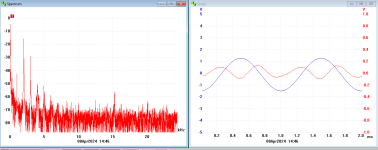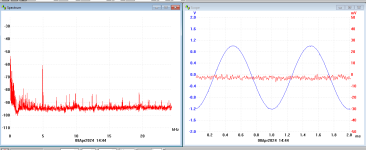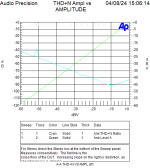Could you please expand on this?
Hello,
Enough said regarding measuring contests.
It helps to look into the mechanisms of distortion and what distortions are disturbing to the listening experience.
In the scheme of things THD is not the worst.
To my ears IMD2 / Amplitude Modulation and the resulting side bands pushed up into the voice range Hz are the most irritating to me.
Nonlinearity in the low Hz causes intermodulation of higher frequencies.
Electricity (current) through the voice coil generates a magnetic field. That field interacts with the magnetic field of the magnet structure. That magnetic field interaction applies a Force to the cone of the driver causing it to move. The force applied to the cone depends on the position of the VC in the magnet gap. the father the VC is away from the neutral position in the gap the more the Force modulates.
Low Hz Hysteresis also causes IMD2
Similar also for for both nonlinearity of the cone suspension and modulation of effective cone area at the limits of VC position.
All these distortion mechanisms show up in IMD2 side bands which can be measured in current distortion across a resistor in series with the driver under test.
Thanks DT
Lars Lisbo leads this line of thinking, trouble is most of his work is behind a paywall at AES.
This paper is similar:
https://bibliotekanauki.pl/articles/176957.pdf
I certainly think IM is a more significant issue. Here is a paper outlining some serious research: https://www.aes.org/e-lib/download.cfm/20459.pdf?ID=20459 It should not be behind a paywall.
These nonlinearitys do show up in the current waveform as long as the voltage is very stiff. If it isn't some will be absorbed by the source.
I could not find anything relating to Lars Lisbo at AES. Can you suggest a better search term?
These nonlinearitys do show up in the current waveform as long as the voltage is very stiff. If it isn't some will be absorbed by the source.
I could not find anything relating to Lars Lisbo at AES. Can you suggest a better search term?
Lars Risbo is the name.I could not find anything relating to Lars Lisbo at AES. Can you suggest a better search term?
https://www.aes.org/events/141/presenters/?ID=5036
I certainly think IM is a more significant issue. Here is a paper outlining some serious research: https://www.aes.org/e-lib/download.cfm/20459.pdf?ID=20459 It should not be behind a paywall.
These nonlinearitys do show up in the current waveform as long as the voltage is very stiff. If it isn't some will be absorbed by the source.
I could not find anything relating to Lars Lisbo at AES. Can you suggest a better search term?
Hello,
I am sorry for the typo in Dr. Lars Risbo name.
The paper was posted on the Purifiaudio website.
Try this link.
https://www.aes.org/e-lib/browse.cfm?elib=18411
Thanks DT
FFT's done with a two tone input do show the amplitude modulation side bands, I said, "wow" when I saw it the first time. It is most auditable.
Last edited:
This is the same @lrisbo who, with Carsten, made the drivers whose distortion I cannot seem to measure accurately.
Seems I’m not the only one who can accurately characterise H2 < -70dB and H3 <-80dB
Close:

https://www.erinsaudiocorner.com/driveunits/purifi_ptt80x04-nab-02/
Closer: (B&K 4133 + 2639 pre-amp)

Reference:
https://hificompass.com/en/speakers/measurements/purifi/purifi-ptt80x04-nab-02

Spec sheet-
https://ptt.purifi-audio.com/document/share/31/dd7edead-c63b-49ef-bfc2-b99f8e02eb19
Seems I’m not the only one who can accurately characterise H2 < -70dB and H3 <-80dB
Close:
https://www.erinsaudiocorner.com/driveunits/purifi_ptt80x04-nab-02/
Closer: (B&K 4133 + 2639 pre-amp)
Reference:
https://hificompass.com/en/speakers/measurements/purifi/purifi-ptt80x04-nab-02
Spec sheet-
https://ptt.purifi-audio.com/document/share/31/dd7edead-c63b-49ef-bfc2-b99f8e02eb19
Last edited:
Hello tktran,Seems I’m not the only one who can accurately characterise it:
First of all, I am not B-Force..
In my view with H2 and H3 levels around 1% or less, sample -to-sample consistency will be a dominant factor. The assumption here seems to be all samples are equal. That is not the case, even with high end stuff such as Purify.
The trend, however, is recognizable; de details should i.m.o. be taken with a grain of salt.
Measurement consistency of an electro-mechanical device is another hurdle. In my experience raising the ambient temperature 5 degrees C .will already produce a different outcome.
@DualTriode
Great. You documented -70dB down for H2 and -80dB down for H3.
Please let me know your measurements conditions- drive level, mic distance, mic, measurement chain. So that I may attempt to replicate such findings. So that when I measure another (unpublished driver) I may actually have a comparison point.
Suppose my measurement chain can only resolve -50dB down, I may be biased to say "-50dB.. hmm, hat's all you need. That's the magic number" And all if all my drivers seem measure in at -50dB down eg. A2000's ACM192 mic:
Refeence:
https://www.mtg-designs.com/tips-tricks-tests/measurement-mic-tests/hd-measurement-mic-tests
I may be prone to stay, well, distortion doesn't matter because they all sound different, they all measured the same.
Great. You documented -70dB down for H2 and -80dB down for H3.
Please let me know your measurements conditions- drive level, mic distance, mic, measurement chain. So that I may attempt to replicate such findings. So that when I measure another (unpublished driver) I may actually have a comparison point.
Suppose my measurement chain can only resolve -50dB down, I may be biased to say "-50dB.. hmm, hat's all you need. That's the magic number" And all if all my drivers seem measure in at -50dB down eg. A2000's ACM192 mic:
Refeence:
https://www.mtg-designs.com/tips-tricks-tests/measurement-mic-tests/hd-measurement-mic-tests
I may be prone to stay, well, distortion doesn't matter because they all sound different, they all measured the same.
Last edited:
The concept of IMD being more harmful is at least a bunch of decades old.Lars Lisbo leads this line of thinking, trouble is most of his work is behind a paywall at AES.
He just repeats the same thing again.
If you have been following the literature over the last couple of decades, nothing that Purifi is doing is mind blowing in that regard.
It's even very ironic, because it basically also means that as long as we just simply remove either any lower frequencies and/or cone excursion, we are left with a lot less IMD.
Or in other words, just split your system up in a subwoofer + mid-range and get similar if not better results.
Even that concept in super old.
This setup is also great for something else and that is attacking those pesky room-modes.
Which is not very practical to do with one woofer that does it all.
A single woofer doing everything would be an absolute no-no for any serious high-end system in my opinion.
Please let me know your measurements conditions- drive level, mic distance, mic, measurement chain.
Okay,
25 degrees C, Pressure near sea level, APx555 analyzer, APx1701 transducer test interface (amplifier), AP500 software + acoustic package. 2.83Vrms output to the speaker and the microphone was placed about 250mm from the dust cap. The speaker was installed in a sealed enclosure about 28L.
The microphone was placed "near field" to minimize room effects.
Just for grins I have a Behringer XLR microphone here. I plan on repeating the measurement with the AP instruments, then one more time with the much less costly Behringer microphone.
I need to clear off my bench and carry the speaker in off the shelf in the garage.
I am a retired Mechanical Engineer, I do this for fun and I am glad to share if you are nice.
Thanks DT
That's only a variance in sensitivity. That's pretty normal, also with GRAS microphones.It's disappointing to me that the M215 varies so much.
You get a calibration sheet and table with the mic up to 31kHz with my later bought ones. (But I don't know if these are with or without protection cap - normally these calibration sheets are WITHOUT protection cap)
I't the cheapest class 1 option I know. Fit's a standard 1/2" calibrator.Given all that, does the M215 variability matter for my use case(s)? Is there a better, similarly priced option? I don't think I want to get into DIY mics or mods. My soldering days are pretty much over. Should I send whatever I buy to Cross Spectrum Labs or purchase it through them?
I would probably send it to a lab for calibratoin after a few years, don't see the need for a new one.
Of course - but will very high quality speaker sit in an average room? I don't hope so ...No THE average room is around 30dB(A), 10dB(A) is far from being average.
Mine are designed for home cinema and studio use. 10-15dB(A) is not uncommon there (at least when you take care of your beamer 🤓 )
No - I wrote I don't UNDERSTAND why people work with very high quality components and use cheap mics for that. When I pay the money for these components I want to check if everything is OK and in spec.But if we go back into the discussion, you were putting a general claim and statement (= average!) out there, that those kind of expensive mics are absolutely mandatory for more expensive systems.
It's not about paying thousends for equipment - get a €500,- mic and an audio interface and you are set. The mic lasts your lifetime.
As the title is "Distortion in Measurement Microphones" it should be clear that you don't have to look at it when you don't care about distortion? Or IMD.Make extremely clear from the beginning that what you're looking for is extremely specific and niche, specifically for YOUR needs.
Doesn't matter if those needs are subjective or objective.
Including your very specific environment as well.
It's just one tech spec of a microphone, more important would be tolerance of the frequency response or alteration over time - but that's not what I measured here.
The quality which is achievable rised a lot! This is part of easy accessible knowlede and cheaper measurement and simulation tools! REW and VirtuixCAD for free - a dream 15 years ago. WaveGuides and a 3D printer, active DSP crossovers ... we are living in the good times of DIY.Oh and btw, I am not talking about "just a DIY-design"......
Although looking at results from guys like Erin's Klippel measurements as well as my own experience, the DIY community has been doing heaps better the last two decades than most professionals to be perfectly honest.
Also the newer generation of drivers ... Bliesma, Purify but also with the "rise" of Klippel equipent chassis quality is way better now.
The Bliesma drivers made my designs perfect, tried plenty other stuff for years and now I'm really happy with the result.
So - these measurements here are for the DIY people to help to decide if a cheap electret mic is good enough for the measurements they want to perform.
For frequency response a calibrated mic should be enough. For IMD you need something better. If you take it serious with THD too. M215 is fine to get for these uses. That's all.
This is what you wrote and that very much reads as a general statement and claim.I have no idea why people think they buy a €50,- microphone and can measure a €500,- top of the line chassis. Just get useful tools, it saves a lot of time (and money in the long run).
Suggesting that cheaper tools aren't useful, will cost people more time as well as money.
As discussed and clearly shown before, that is just not true or only true in very specific niche cases.
I know and I'm fully aware, still doesn't change what kind of message people trying to tell.As the title is "Distortion in Measurement Microphones" it should be clear that you don't have to look at it when you don't care about distortion? Or IMD.
It's just one tech spec of a microphone, more important would be tolerance of the frequency response or alteration over time - but that's not what I measured here.
I already said that I am all interested in results and data.
I only don't agree with the message (see above) that it's absolutely mandatory to design speakers.
Expensive or not
Last edited:
Except for the waveguide tools. Most other things have been available for at least 15-20 years by now.The quality which is achievable rised a lot! This is part of easy accessible knowlede and cheaper measurement and simulation tools! REW and VirtuixCAD for free - a dream 15 years ago. WaveGuides and a 3D printer, active DSP crossovers ... we are living in the good times of DIY.
ARTA, Edge/Basta, Speakerworkshop, HolmImpulse, LspCAD, Akabak and many many other tools have been around for DIY'ers.
At the end of the day, we are all niche- 98% of population are happy with a blackbox speaker the size of a quart of milk (~1L). As long as it has Bluetooth…
We can debate which tests are useful/useless, including HD, IMD, CEA 2010, IEC 60268-21 etc, but just like transducers, frequency response is king. SPL smoothness and dynamic range (difference between minimum and maximum) range determines what can be measured properly, and what cannot.
We are a community of collaborators here.
Soon you may see more comparisons from others, including all manner of microphones…
Thanks again @IamJF for publicly showing his data.
We can debate which tests are useful/useless, including HD, IMD, CEA 2010, IEC 60268-21 etc, but just like transducers, frequency response is king. SPL smoothness and dynamic range (difference between minimum and maximum) range determines what can be measured properly, and what cannot.
We are a community of collaborators here.
Soon you may see more comparisons from others, including all manner of microphones…
Thanks again @IamJF for publicly showing his data.
"I have no idea why people think they buy a €50,- microphone and can measure a €500,- top of the line chassis. Just get useful tools, it saves a lot of time (and money in the long run)."
Good tools SAVE money - cause you don't have to rebuy them. I also have 2 of these Behringer mics ... wasted money. I also have 3 cheap routers (2 of them now damaged) ... until I bought a Makita.
And they save time cause you can rely on the result, less double checking, less discussing on forums, ... 😎 I don't need a correction file for my M50 - that's really nice to have when you use different measurement platforms (AP, REW on different computers, Dirac, NTi XL2 for me).
Some learn it quicker, some need to pay the money ... (like I did 🤓 )
Can you measure the properties of a Purify chassis with a €50,- microphone? No. That's what I wrote. You can measure SOME properties. But you don't buy a Purify cause of the nice frequency response ... it's the low THD and IMD.This is what you wrote and that very much reads as a general statement and claim.
Suggesting that cheaper tools aren't useful, will cost people more time as well as money.
Good tools SAVE money - cause you don't have to rebuy them. I also have 2 of these Behringer mics ... wasted money. I also have 3 cheap routers (2 of them now damaged) ... until I bought a Makita.
And they save time cause you can rely on the result, less double checking, less discussing on forums, ... 😎 I don't need a correction file for my M50 - that's really nice to have when you use different measurement platforms (AP, REW on different computers, Dirac, NTi XL2 for me).
Some learn it quicker, some need to pay the money ... (like I did 🤓 )
At these SPLs, air gets very non-linear and distorts
Here's how Siegfried Linkwitz estimated this (from https://www.linkwitzlab.com/images/graphics/air-distortn.gif):
- Home
- Loudspeakers
- Multi-Way
- Distortion in Measurement Microphones - actual measurements



